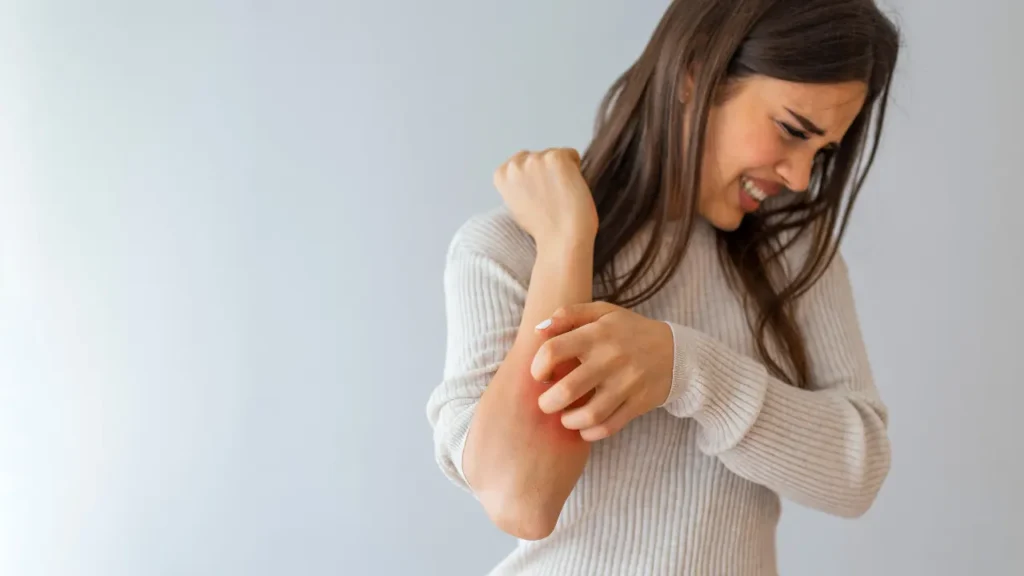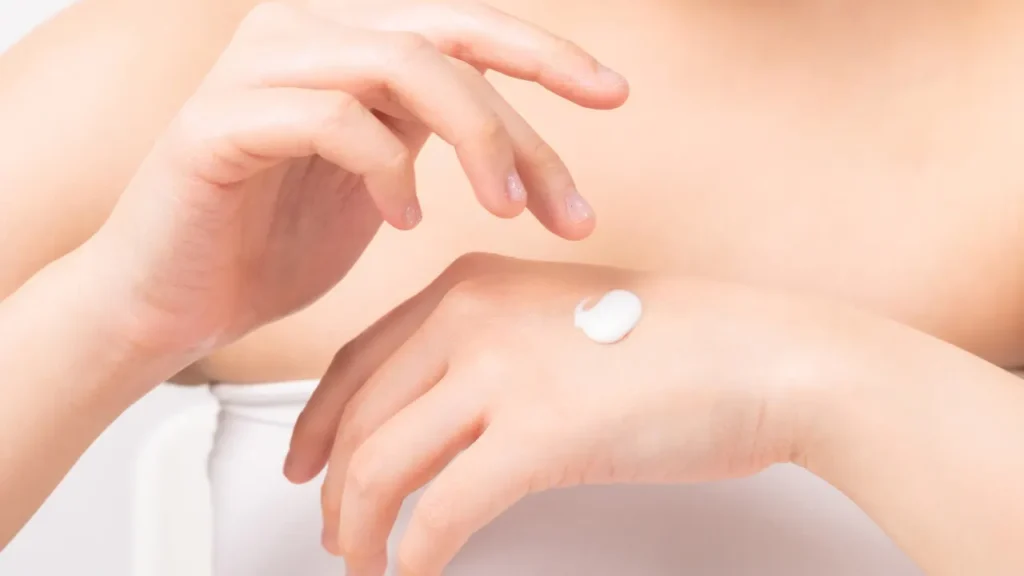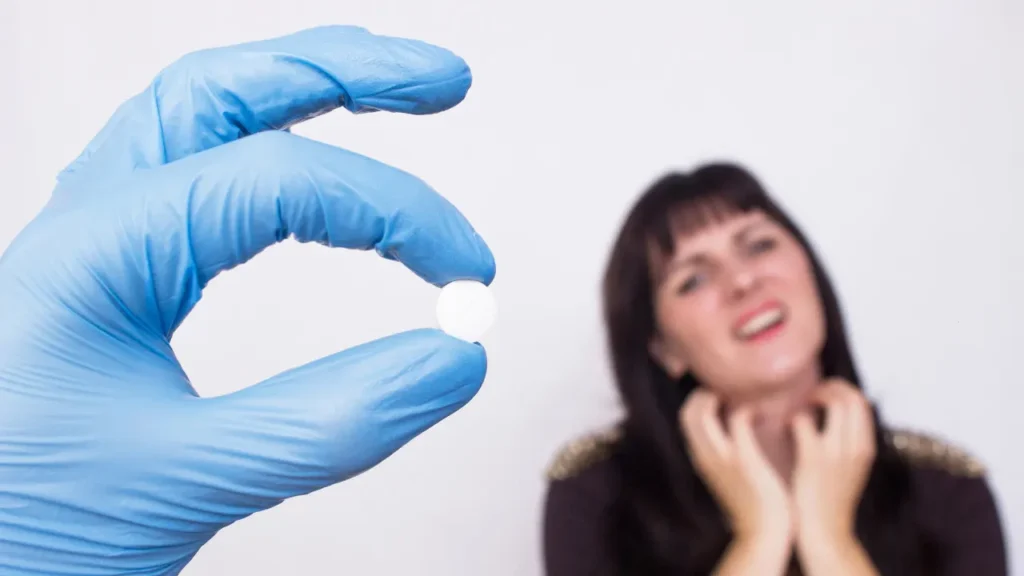Description
Eczema that manifests as contact dermatitis happens when an allergen or an irritant gets into contact with the skin. Allergic contact dermatitis and irritating contact dermatitis are two different forms of contact dermatitis. When the skin gets into contact with something that harms the skin, like alkalis, acids, solvents, detergents, or friction, irritant contact dermatitis develops. When the skin gets into contact with something that the body perceives as foreign, like nickel, or poison ivy, allergic contact dermatitis develops. When a delayed hypersensitivity response occurs, allergic contact dermatitis happens between 24 and 48 hours after being exposed to the allergen.
Skin irritation, itching, and redness are all signs of contact dermatitis. The impacted area may develop cracks, scaly patches, and dryness. In severe situations, the skin may develop blisters and turn rough and weepy. Dermatitis can appear anywhere on the body, although the face, arms, and hands are the most frequently affected regions.
You May Also Like:
FINDING THE BEST LION’S MANE MUSHROOM SUPPLEMENT: 5 TOP BRANDS REVIEWED
THE CONNECTION BETWEEN MUSHROOMS AND COVID: 5 GREAT REASONS TO TRY FUNCTIONAL MUSHROOMS
Contact Dermatitis: Description, Causes, And Treatment Protocol is an original (HealthXWire) article.
Possible Causes
There are numerous reasons why contact dermatitis can develop. The following are some of the usual causes of contact dermatitis:
Irritants: Contact dermatitis may develop after being exposed to irritants like soaps, detergents, and solvents. Irritating substances can deplete the skin’s natural oils, causing dryness, redness, and irritation.
Allergens: The most frequent reason for contact dermatitis is allergens. In cosmetics and personal care items including soaps, shampoos, and lotions, they can be found as nickel, latex, perfume, and preservatives.
Plants: Contact dermatitis may be caused by exposure to plants like poison oak, poison sumac, and poison ivy. When urushiol, a compound found in these plants, gets into direct interaction with one’s skin, it might result in an itchy rash.
Chemicals: Contact dermatitis may result from exposure to substances like chromium, formaldehyde, and cobalt.
Infections: Bacterial, fungal, and viral infections can sometimes cause contact dermatitis. Infections can occur due to breaks in the skin caused by scratching or other irritants.
Sunlight: Exposure to sunlight can cause photo-toxic dermatitis, which is a type of contact dermatitis that occurs due to the interaction between UV rays and certain chemicals present on the skin.
Medications: Some medications, including topical antibiotics and corticosteroids, can cause contact dermatitis. In rare cases, systemic medications can also cause a skin reaction.
Exacerbating and Mitigating Factors
Contact dermatitis can be exacerbated or lessened by a number of causes. These consist of the following:
Duration of Exposure: The possibility of acquiring contact dermatitis increases the longer your skin is exposed to the allergen or irritant.
The Concentration of the Allergen or Irritant: You are more likely to suffer from contact dermatitis if there is a larger concentration of an irritant or allergen.
Skin Barrier Function: The probability of getting contact dermatitis can rise if the skin barrier gets compromised.
Skin Sensitivity: The likelihood of developing contact dermatitis is higher among individuals with sensitive skin than in those with normal skin.
Skin Hydration: Contact dermatitis can affect dry skin more easily than moisture-rich skin.
Age: Young people and children are more likely than older people to develop contact dermatitis.

Standard Treatment Protocol(s)
Identification and avoidance of the allergen or irritant, alongside the treatment of the symptoms, are all parts of the standard treatment regimen for contact dermatitis. The following are possible course of action alternatives:
Recognizing the Irritation or Allergy and Avoiding it: Finding and avoiding the trigger ingredient is the initial step in addressing contact dermatitis.
Topical Corticosteroids: The most popular form of therapy for contact dermatitis involves topical corticosteroids. They aid in reducing itchiness and inflammation.
Topical Antihistamines: Itching can be controlled by applying topical antihistamines like hydroxyzine and diphenhydramine.
Topical Calcineurin Inhibitors: For the medical management of contact dermatitis, topical calcineurin inhibitors like tacrolimus and pimecrolimus provide a substitute for corticosteroids. They function by preventing the immunological reaction that results in the swelling and itching that are part of the illness.
Oral Antihistamines: Itching can be relieved by using oral antihistamines like loratadine and cetirizine.
Emollients: Emollients are effective ways to hydrate the skin and stop dryness and cracking, which include aqueous cream or petroleum jelly.
Wet dressings: To help calm the skin and minimize inflammation, wet dressings can be placed in the affected region.
The following therapies may be suggested for contact dermatitis situations that are more severe:
Oral corticosteroids: Prednisone or other oral corticosteroids can be used in extreme circumstances to treat inflammation and irritation.
Phototherapy: UV radiation is used in phototherapy as it can relieve inflammation and irritation.
The administration of calcineurin inhibitors and topical corticosteroids includes the potential to cause unwanted side effects, like skin thinning and an elevated risk of infection if taken for extended periods of time. As a result, it is important to strictly adhere to your doctor’s advice when taking these medicines.

Treatment Options
There are numerous therapy alternatives available that can aid in treating contact dermatitis in addition to the typical treatment methods. Prescription drugs, over-the-counter medicines, and dietary supplements, including herbal and natural therapies, are among them.
Prescription Medications: A number of additional prescription drugs can be used for treating contact dermatitis besides the common ones mentioned above. The following list comprises them:
- Immunomodulators
When alternative treatments fail to relieve severe instances of contact dermatitis, immunomodulators like cyclosporine and azathioprine might be administered.
Antibiotics: In case an infection exists in the affected region, antibiotics may be recommended by your doctor.
Biologics: Atopic dermatitis, a severe form of eczema that might be caused by contact with specific substances, may be treated with biologics like dupilumab.
Over-the-Counter Formulations: Contact dermatitis can be treated with a number of over-the-counter medications. The following are some of them:
Topical Antihistamines: Itching can be reduced by applying topical antihistamines like diphenhydramine lotion.
Calamine lotion: Calamine lotion can be used to calm the skin and alleviate itching.
Topical Hydrocortisone: Itching and irritation can be reduced by using topical hydrocortisone cream.
Furthermore, there are a number of nutritional supplements along with natural cures that can be used in conjunction with conventional therapy alternatives or that may even increase the effectiveness of such treatments. The following are some of them:

Nutritional Supplements: The following dietary supplements have been demonstrated to be effective in treating contact dermatitis:
- Omega-3 fatty acids
Fish oil supplements include omega-3 fatty acids, which have anti-inflammatory characteristics and may help decrease the inflammation brought on by contact dermatitis. Atopic dermatitis, a kind of eczema that resembles contact dermatitis in certain ways, can be less severe, according to a study that was published by the Journal of Investigative Dermatology.
- Vitamin D
Skin barrier function alongside the control of the immune system is significantly influenced by vitamin D. According to a study by the British Journal of Dermatology, having low vitamin D levels increases the chance of developing atopic dermatitis.
- Zinc
Your immune system and the health of your skin both depend on zinc. Zinc supplementation has been shown to help lessen the severity of atopic dermatitis, according to a study that was published by the Journal of Cutaneous Medicine and Surgery.
- Probiotics
Lactobacillus and Bifidobacterium, two probiotics, can assist in reducing inflammation and enhancing the function of the skin barrier. Probiotics may be able to decrease the extent of atopic dermatitis, according to a study by the Journal of Allergy and Clinical Immunology.
Herbal remedies: The management of contact dermatitis may potentially benefit from a number of herbal treatments. The following represent a few of the herbal treatments that are most frequently used:
- Aloe Vera
On account of its anti-inflammatory properties, aloe vera may be able to decrease the inflammation brought on by contact dermatitis. Aloe vera gel has been shown in a study to help alleviate the extent of atopic dermatitis, which was published by the Journal of Dermatological Treatment.
- Coconut Oil
Applying coconut oil topically may hydrate the skin and relieve dryness and cracking.
- Tea Tree Oil
Tea tree oil may be used topically to soothe irritation and inflammation since it possesses anti-inflammatory and antibacterial effects.
- Chamomile
Antioxidant and anti-inflammatory properties of chamomile can help lessen inflammation and safeguard the skin from harm. Chamomile can decrease the symptoms of atopic dermatitis, according to a study reported by the Journal of Clinical and Aesthetic Dermatology.
- Calendula
Calendula may be administered topically to relieve itching and swelling and it contains antibacterial and anti-inflammatory properties.
- Oatmeal
Applying oatmeal directly on your skin or using it as a bath additive can help soothe itchy skin.
- Licorice root
Inflammation and irritation can be reduced by topically using licorice root, which possesses anti-inflammatory properties.
- St. John’s Wort
To lessen inflammation and irritation, St. John’s Wort can be used topically. It possesses anti-bacterial and anti-inflammatory effects.

Conclusion
While herbal treatments may be useful in controlling contact dermatitis, it is crucial to remember that they should not to be used in place of required medical care. Before taking any kind of herbal medication, it is crucial to check with a healthcare professional to be assured it is secure and suitable for usage.
Additional resources for further reference
https://www.aad.org/public/diseases/eczema/types/contact-dermatitis
https://my.clevelandclinic.org/health/diseases/6173-contact-dermatitis
https://www.webmd.com/skin-problems-and-treatments/contact-dermatitis
Important Note: The information contained in this article is for general informational purposes only, and should not be construed as health or medical advice, nor is it intended to diagnose, prevent, treat, or cure any disease or health condition. Before embarking on any diet, fitness regimen, or program of nutritional supplementation, it is advisable to consult your healthcare professional in order to determine its safety and probable efficacy in terms of your individual state of health.
Regarding Nutritional Supplements Or Other Non-Prescription Health Products: If any nutritional supplements or other non-prescription health products are mentioned in the foregoing article, any claims or statements made about them have not been evaluated by the U.S. Food and Drug Administration, and such nutritional supplements or other health products are not intended to diagnose, treat, cure, or prevent any disease.
Table of Contents


